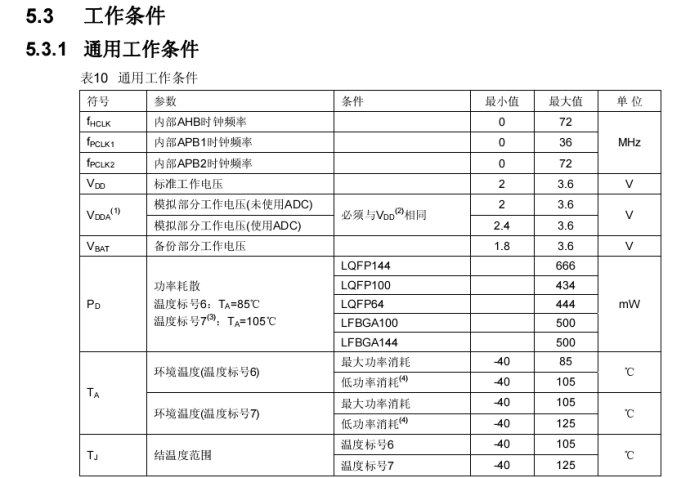This article mainly analyzes SPI1 because SPI1 is somewhat special on the clock line APB2.
1. To analyze the SPI communication rate, we must first check the STM32F103 datasheet and the commonly used working conditions, as shown in the figure below.

2. From the datasheet, we can know that the communication rate of SPI1 can reach 18MHz, as shown in the figure below.
From the datasheet, we know that the communication rate of SPI1 can reach 18Mb/s. If SPI is configured with 8-bit data width, the frequency is 18MHz. This rate is only measured under common working conditions. It does not mean that SPI1 can only reach 18MHz at most. fPCLK2 is 72MHz, and SPI1 must be divided by at least two, so the maximum clock frequency of SPI1 is 36MHz. This frequency is already overclocked under common conditions. 18MHz is only the rate under the most stable conditions measured by the official, so the clock frequency of SPI is not limited to 18MHz. In view of the fact that the maximum frequency of SPI can only be 36MHz as stated on the Internet, I do not agree. Even if fPCLK2 is 72MHz and the SPI1 clock is divided by 2, it will not be limited to 18MHz, but still 36MHz.
Previous article:[STM32 peripheral ADC details]-Differences between injection group and rule group
Next article:STM32F103 clock configuration process
- Popular Resources
- Popular amplifiers
 Professor at Beihang University, dedicated to promoting microcontrollers and embedded systems for over 20 years.
Professor at Beihang University, dedicated to promoting microcontrollers and embedded systems for over 20 years.
- LED chemical incompatibility test to see which chemicals LEDs can be used with
- Application of ARM9 hardware coprocessor on WinCE embedded motherboard
- What are the key points for selecting rotor flowmeter?
- LM317 high power charger circuit
- A brief analysis of Embest's application and development of embedded medical devices
- Single-phase RC protection circuit
- stm32 PVD programmable voltage monitor
- Introduction and measurement of edge trigger and level trigger of 51 single chip microcomputer
- Improved design of Linux system software shell protection technology
- What to do if the ABB robot protection device stops
- Innovation is not limited to Meizhi, Welling will appear at the 2024 China Home Appliance Technology Conference
- Innovation is not limited to Meizhi, Welling will appear at the 2024 China Home Appliance Technology Conference
- Huawei's Strategic Department Director Gai Gang: The cumulative installed base of open source Euler operating system exceeds 10 million sets
- Download from the Internet--ARM Getting Started Notes
- Learn ARM development(22)
- Learn ARM development(21)
- Learn ARM development(20)
- Learn ARM development(19)
- Learn ARM development(14)
- Learn ARM development(15)
- How to use a power amplifier to amplify and output a pulse train signal? How to use the Burst function of a signal generator?
- 【DIY Creative LED】LED lights and holes
- Surge arrester explanation and working principle
- Is there any error in the schematic diagram of the electrostatic generator?
- Cheap_Flash_FS (SPI_Flash version) -- embedded SPI_FLASH file system free source code, please download
- How to write interrupt function after using library function in MSP430F5529
- TPS61040 boost circuit abnormality
- [Atria AT32WB415 series Bluetooth BLE 5.0 MCU] + CAN communication
- What does it mean when a pushpin icon is displayed during STM32CubeMX pin configuration?
- Does TI C6678 support flash partitioning?

 LTC2050HVIS6#PBF
LTC2050HVIS6#PBF
















 京公网安备 11010802033920号
京公网安备 11010802033920号